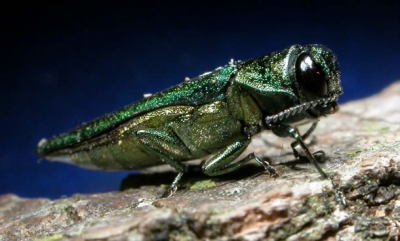
Emerald Ash Borer side view. More photos at http://www.emeraldashborer.info/photos.cfm. Photo Courtesy emeraldashborer.info.
Pest was Discovered in PG County and Authorities Fear it Could Find Its Way to So. Md. via Firewood Suppliers
ANNAPOLIS, Md. - A little-known insect threatens southern Maryland's ash trees. The insect, the emerald ash borer, has already caused extensive damage to trees in other states. The borer was discovered in Prince George's County in 2003. Authorities say that it could easily be transported into the southern Maryland area by unsuspecting firewood buyers. They also say that unless the pest is stopped, it could destroy all of the ash trees in Maryland and eventually the United States.
The emerald ash borer (Agrilus planipennis), a.k.a. the Green Menace, is a devastating exotic pest of ash trees. Because of the emerald ash borer, more than 20 million ash trees have died in Michigan, Ohio, Illinois and Indiana. It is native to Asia and thought to have arrived in the United States in solid wood packing material from its native Asia.
It was first detected in the Detroit, Michigan/Windsor, Ontario area in July 2002. A federal quarantine for emerald ash borer is now in effect over the Lower Peninsula of Michigan and all of Ohio, Indiana, and Illinois. These states also maintain interior quarantines to prevent intrastate spread of this pest. The 2006 discovery of this pest in an area of Maryland where it was believed to have been eradicated after a regulatory incident in 2003 has earned the emerald ash borer its place as the Maryland Invasive Species Council's January, 2007, Invader of the Month.
The story of the emerald ash borer in Maryland started in April of 2003 when a nursery in the Clinton/Brandywine area of Prince George's County unknowingly received infested ash nursery stock from Michigan, shipped in violation of a Michigan quarantine. By the time that a Maryland Department of Agriculture (MDA) inspector detected the infestation in August of that year, adult beetles had emerged and infested other trees in the nursery. The MDA, with support from the U.S. Department of Agriculture, Animal Plant Health Inspection Service (APHIS), the Maryland Department of Natural Resources (DNR), and many others, destroyed more than 1100 ash trees on 500 acres in a ½ mile buffer around the nursery. The MDA also identified and removed all ash trees transplanted into other areas by landscapers. Since the original detection and eradication, the MDA conducted annual survey programs in affected areas and found no new beetles, until..
On August 15, 2006, emerald ash borer beetle larvae were found in a "trap" tree placed by state officials in the eradication area. The Maryland Secretary of Agriculture issued a Quarantine Order on August 21, 2006, restricting the movement of all ash wood and nursery stock and all hardwood firewood from the County. A massive cooperative eradication effort involving federal, state and local officials, private contractors, public utilities, landowners, and business people is again underway. All ash trees within a 1 ½ mile buffer will be inventoried, cut, and ground to less than 1 inch in diameter in two dimensions to destroy all emerald ash borer larvae and pupae that may be overwintering under the bark. As of this writing more than 11,500 acres are impacted. The MDA is also conducting delimiting surveys to be sure that the eradication area is adequate. Eradication must be completed by the end of March before adult emerald ash borers emerge and infest more ash trees.
The emerald ash borer is only known to attack ash trees (genus Fraxinus) in North America, always with fatal results. Adult beetles are bright metallic green with rounded bellies and flat backs, one-third to one-half inch long. They emerge in the spring and lay eggs on the bark of ash trees. The creamy white larvae hatch and move into the cambium layer. They live most of the year under the bark of ash trees, feeding on the tissue that carries food and water up and down the tree, effectively girdling the tree and starving it to death. Infested trees show symptoms within a year. The upper third of a tree dies back first, followed by the rest the next year. This is followed by many shoots or sprouts emerging below dead portions of the trunk. The canopy continues to decline until the tree eventually dies.
What is at stake if the emerald ash borer isn't stopped? In Maryland, ash is the most common street tree in Baltimore, making up about 10% of total trees. Ash accounts for over 3 percent of trees in naturally wooded area in Baltimore and surrounding counties. USDA has estimated that losses could reach almost $300 million in the Baltimore area alone. The Maryland DNR also estimates that about 20 percent of our riparian trees, vital to the health of the Chesapeake Bay, are ash trees. USDA estimates that at the national level, if the emerald ash borer went unchecked in the lower 48 states, the undiscounted loss could range from $20 - $60 billion dollars. Ash wood is used for all traditional applications of hardwood from flooring and cabinets to baseball bats.
The emerald ash borer threatens to kill all ash trees in Maryland and ultimately the United States if not stopped. Maryland is the farthest, and only non-contiguous, of the infested states. Many exotic pests such as the emerald ash borer, which doesn't move much farther than ½ mile per year on its own, can be carried on infested wood by humans hundreds and even thousands of miles to new areas.
Stopping the spread of the emerald ash borer will take more than regulations. Everyone can help! Be an ambassador by watching for and reporting symptoms, not moving ash wood, and spreading the word about the quarantine and the perils of moving hardwood firewood.
For more information about the emerald ash borer and the Maryland quarantine and eradication program, visit the national coordinated emerald ash borer web site, http://www.emeraldashborer.info and click on the "Maryland" link, or go directly to http://www.mda.state.md.us/plants-pests/eab .


